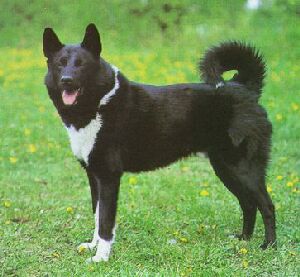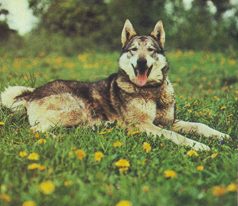Laykas
Layka is the most ancient group of the breeds of the hunting dogs. These dogs are capable to various hunt almost without any training only by virtue of the hunting instinct close to a primitive instinct of a wild predator, they accompanied a hunter and helped him to find food in the northen forest zone of Europe and Asia.
In August and September laykas turn hiding feathered birds out of the grass and overgrowth, search and bring the thrown down birds to a hunter, at meeting with a wood grouse and blackcock they drive them on trees and bark them on. Later such a dog finds fiber, sable and marten on trees, finds out polecat, column hidden in the holes, point out underice ways of mink and otter. And at a case it gives the opportunity to shoot bear, lynx, it stops boar and lamb.
But frequently such universality is not desirable. For example, the hunters on a large animal and sable hunters do not allow their dogs to bark out fiber and the feathered birds.
Such breeds of laykas as karelo - finnish, russian - european and westsiberian are wide spread in Mari El repablic.
Russian - european layka.
Russian - european laykas are of average growth, the height of them is about 52 - 58 cm. The most widespread and preferable colour is black and black - piebald. This colour is very convenient at the hunt as it is noticeable and lets not to confuse a dog with an animal.

The character of the majority russian - european laykas mobile, easy going but to a less degree than the one of the dogs of karelo - finnish breed. These laykas are especially good for the hunting on fiber, the pine forest game and sometimes on a large animal. Some dogs work successfully on mink and otter. At the duck hunt and during the pursuit of the animal by an old trace these laykas yield to the taller and more even - minded west siberian laykas.
The breed was generated by crossing Komi, Arkhangelsk, Udmurt and some other laykas. The basic factory nucleus of this breed, in particular its founder the champion Putik, is deduced in the nursery of All-Union hunt research institute in Kalininsk region, which later on was transferred to Kirov city.
West siberian layka.

These dogs are larger than the previous ones, their growth reaches 55 - 60 cm. In last years the undesirable tendency to increasing of growth at the containing in the urban conditions in connection with a plentiful meal is marked. The colour can be of all kinds, one - tone or piebald, except for brown and tiger colour. The most distributed are white, grey and red colour, one - tone or with spots. Black and black - piebald are also supposed.
The temperament is rather quiet, counterbalanced. Working they frequently don`t show extremely dynamic style, which is typical for the other laykas, but the hunt with them is not less bootyfull. Among west siberian laykas there are a lot of good "duck hunters", these dogs work successfully on the cooled down trace of the past animal as well as on a large animal.
The breed is deduced on the basis of the merge of hanty, mansi and others laykas which were bred at the Ural and in the Western Siberia.
Karelo - finnish layka.

The formation of the breed as the factory one took the beginning in the early 1950 th. For its beginning the breed is obliged mainly to the efforts of the enthusiasts spouses L.A.Gibet and L.P.Nikiforov. Charmed by the outstanding field qualities of their first pupil Zorka - of the dog with unknown origin but rather typical they have been keeping the "blood" of the initial productive dog simultaneously with the improvement of the kind of their pupils for 40 years.
The successful infusion of blood of the thoroughbred finnish laykas has enriched the gene fond to a marked degree and it`s improved the exterrier of the rising breed.
Now the basic centres of the cultivation of karelo - finnish laykas, besides Moscow and Leningrad regions, are Kirov, Yaroslavl, Gorky and some other regions.
The red colour makes some inconvenience at is gives a dog dangerous similarity with a fox. The extremely alive mobile temperament of karelo - finnish laykas provides very dynamic and productive style of their work on a fiber and the pine forest game. But it is up to the same quality to complicate the teaching them to work on the cooled down trace of an animal.
The regular crossing of karelo - finnish laykas with Finnish ones which has been being practised has caused some doubts about the status of this breed in the kinologic circles. Some kinologic experts are inclined to consider the "karelo - finns" only as an original branch in the breed of finnish laykas.
Karelo - finnish layka is the less numerous among the other laykas in Mari El.
| Республика Марий Эл | Hunting in Mari El | Guestbook |
| documents | hunting dogs | hunting animals | hunter to hunter |
| dictionary (rus) | site contents |
All right reserved
You may send Your tenders to: Serg V.Surkov